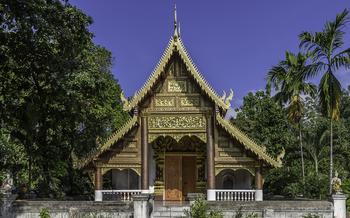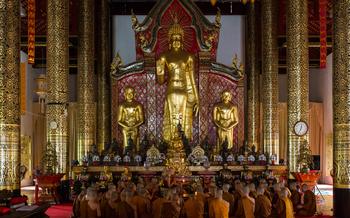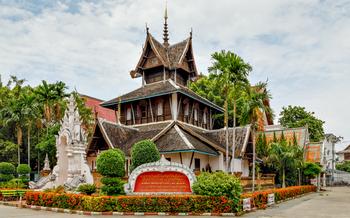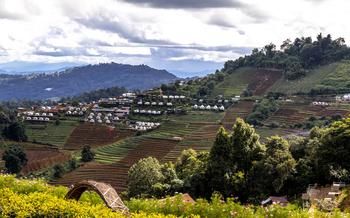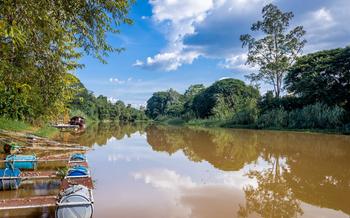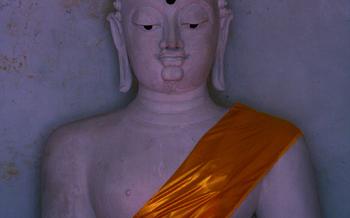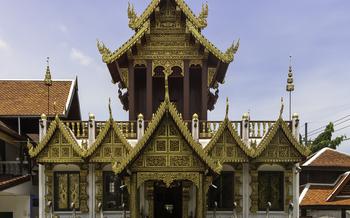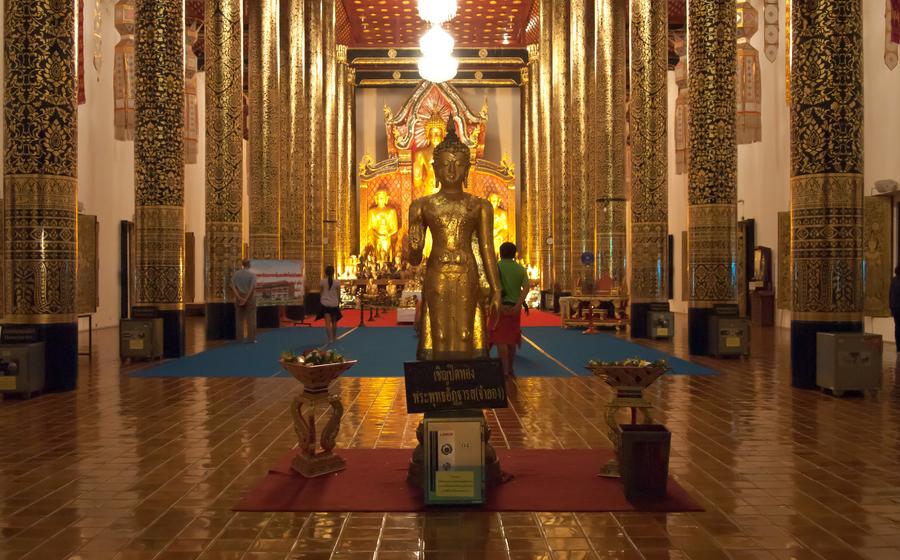
Wat Ta Eua
- Historical Background
- Location and Accessibility
- Temple Complex
- Buddha Images
- Ordination Hall
- Meditation and Retreats
- Local Festivals and Events
- Local Markets and Shops
- Food and Dining Options
- Photography and Videography
- Guided Tours and Local Guides
- Nearby Attractions and Itineraries
- Insider's Tip:
Historical Background
Wat Ta Eua is a Buddhist temple with a rich history dating back to the 15th century. It was founded by King Tilokaraj, the ruler of the Lanna Kingdom, as a forest monastery. Over the centuries, the temple has undergone several renovations and expansions, reflecting the devotion and patronage of successive rulers and the local community.
The temple's architectural style is a blend of Lanna and Burmese influences, showcasing intricate carvings, colorful murals, and graceful stupas. Wat Ta Eua holds a significant place in the hearts of Chiang Mai residents, serving as a center for religious ceremonies, community gatherings, and spiritual teachings. It is also a popular destination for pilgrims and tourists alike, who come to admire its architectural beauty, pay homage to the sacred Buddha images, and experience the serenity of this sacred space.
Location and Accessibility
Situated in the heart of Chiang Mai, Wat Ta Eua is a prominent landmark located on Si Donchai Road, Tambon Chang Klan, Amphoe Mueang Chiang Mai. This ancient temple is easily accessible, with various transportation options available to visitors. The temple is within walking distance from the bustling city center, allowing visitors to combine their visit with other attractions in the area.
For those who prefer public transportation, numerous songthaews (shared taxis) and buses pass by the temple, making it convenient to reach from various parts of the city. If you're traveling by car, Wat Ta Eua offers ample parking space, ensuring a hassle-free visit. Guided tours are also available, providing a comprehensive exploration of the temple's history, architecture, and significance. These tours often include transportation to and from your hotel, making it an organized and informative option for visitors.
To enhance your experience, plan your visit during the early morning or late afternoon, when the sunlight casts a warm glow on the temple's intricate details. This timing also allows you to avoid the midday heat and crowds, ensuring a more serene and peaceful exploration of this sacred site.
Temple Complex
The temple complex of Wat Ta Eua is a testament to the artistic and architectural prowess of its builders. The layout follows the traditional Lanna style, with the main temple building, known as the viharn, dominating the complex. The viharn houses the principal Buddha image, Phra Buddha Sihing, and features intricate murals depicting scenes from the life of Buddha and Buddhist cosmology.
Flanking the viharn are two smaller buildings, the ubosot (ordination hall) and the ho trai (library). The ubosot is used for ordination ceremonies and other sacred rituals, while the ho trai houses the temple's collection of Buddhist scriptures and manuscripts.
Smaller stupas, or chedis, dot the complex, each representing a significant event or figure in Buddhist history. These stupas, along with the surrounding lush gardens and serene atmosphere, create a tranquil and meditative environment that invites visitors to immerse themselves in the spiritual essence of the temple.
Buddha Images
The sacred Buddha images enshrined within the temple are of immense significance to both the local community and visitors. Among them, the most revered is the Phra Buddha Sihing, a 15th-century bronze sculpture renowned for its exquisite craftsmanship and spiritual aura. Believed to have been created by a legendary monk, Phra Ruang, the image is deeply cherished by the local people and is considered a symbol of good fortune and prosperity.
Another notable Buddha image is the Phra Buddha Chinnarat, known for its graceful and serene features. Cast in bronze during the 15th century, this image embodies the epitome of Thai Buddhist art and is highly revered throughout the country. The Buddha's serene countenance, elongated earlobes, and delicate fingers exude an aura of tranquility and compassion, inspiring devotion and reverence among visitors.
The temple also houses several smaller Buddha images, each with its own unique history and significance. These images represent different mudras, or hand gestures, symbolizing various aspects of the Buddha's teachings, such as meditation, teaching, or protection. Visitors can spend hours exploring the temple's collection of Buddha images, appreciating their intricate details and the stories they hold.
Ordination Hall
The ordination hall, also known as the Ubosot, is a sacred and essential structure within the Wat Ta Eua temple complex. It serves as the primary venue for significant Buddhist ceremonies, particularly monk ordinations. These ordination rituals are deeply rooted in Thai culture and Buddhism, symbolizing the transition of individuals into the monastic life.
Within the ordination hall, visitors can witness or participate in these sacred ceremonies, which involve chanting, meditation, and the bestowal of saffron robes upon the candidates. The hall is adorned with intricate murals depicting scenes from the Buddha's life and teachings, adding to the solemnity and spiritual atmosphere.
Beyond monk ordinations, the ordination hall is also used for other Buddhist ceremonies, including merit-making rituals and special religious observances. It is a place where the community gathers to celebrate, pray, and seek blessings. Visitors are welcome to enter the ordination hall during non-ceremony hours to admire its serene beauty and learn about its profound significance in Thai Buddhism.
Meditation and Retreats
Wat Ta Eua serves as a sanctuary for spiritual growth and inner peace, offering visitors the opportunity to engage in meditation and spiritual retreats. The temple's serene atmosphere and dedicated meditation spaces provide an ideal setting for introspection and self-discovery. Visitors can choose from various meditation techniques, including mindfulness meditation, mantra chanting, and guided meditation. The temple also organizes meditation retreats for those seeking a more immersive experience, allowing participants to deepen their practice and connect with their inner selves. Whether you're a seasoned meditator or a beginner looking to explore the transformative power of meditation, Wat Ta Eua provides a welcoming and supportive environment for your spiritual journey.
Local Festivals and Events
Wat Ta Eua is not only a place of worship but also a vibrant center for local festivals and events throughout the year. These festivals offer a unique opportunity for visitors to immerse themselves in Thai culture and traditions.
One of the most significant festivals celebrated at Wat Ta Eua is Songkran, the Thai New Year. During Songkran, which falls in April, the temple becomes a hub of activity as locals and visitors come together to celebrate the new year with water splashing, merit-making, and traditional parades.
Another important festival is Loi Krathong, the Festival of Lights, which takes place in November. During Loi Krathong, people gather at the temple to release beautifully decorated krathongs, or floating baskets, into the moat surrounding the temple. This festival symbolizes letting go of past grievances and bad luck while making wishes for the future.
Visitors to Wat Ta Eua during these festivals can expect to witness colorful processions, traditional music and dance performances, and a lively atmosphere filled with joy and celebration. Participating in these festivals is a wonderful way to experience the rich cultural heritage of Thailand and connect with the local community.
Local Markets and Shops
Around the temple grounds, a vibrant local market bustles with activity, offering a glimpse into the daily life and culture of Chiang Mai. Here, visitors can immerse themselves in the sights, sounds, and aromas of Thailand's vibrant street markets. Stalls selling an array of local delicacies, handcrafted souvenirs, and religious items line the narrow alleys, creating a kaleidoscope of colors and textures.
From fragrant jasmine garlands and intricately carved Buddha statues to colorful handmade textiles and unique handicrafts, the market offers a treasure trove of unique souvenirs to take home. Visitors can haggle with friendly vendors, experiencing the art of bargaining that is an intrinsic part of Thai culture.
The market also presents an opportunity to sample the delicious local cuisine. Food stalls offer a tempting array of freshly prepared Thai dishes, from the iconic Khao Soi, a rich coconut-based curry noodle soup, to Sai Oua, a flavorful northern Thai sausage. Vegetarian and vegan options are also available, catering to the diverse dietary needs of visitors.
Food and Dining Options
After exploring the sacred grounds of Wat Ta Eua, tantalize your taste buds with a culinary journey in the vibrant markets and restaurants surrounding the temple. Indulge in the aromatic flavors of Khao Soi, a rich coconut-based curry noodle soup, or savor the spicy and savory Sai Oua, a traditional Northern Thai sausage. Vegetarians and vegans will delight in the diverse meat-free options, such as Pad Pak Ruam, a stir-fried medley of fresh vegetables, or the flavorful Tom Kha, a coconut-infused soup. Remember to embrace the local dining culture by embracing street food stalls, where you can interact with friendly vendors and experience the authentic taste of Chiang Mai cuisine. Embrace the communal spirit by sharing dishes and engaging in lively conversations with fellow diners.
Photography and Videography
When visiting Wat Ta Eua, it's essential to be mindful of the temple's policy regarding photography and videography. While photography is generally allowed in most areas of the complex, there may be specific places or activities where it's restricted. These restrictions are typically in place to maintain the sanctity and privacy of the temple environment.
Before taking any photos or videos, it's respectful to ask for permission from the monks or temple staff. They will be able to guide you on the appropriate places and activities to capture. It's also important to avoid using flash photography, as it can be disruptive to the serene atmosphere of the temple.
When taking photos or videos, remember to be respectful of the people and activities around you. Avoid capturing images of individuals without their consent, and be mindful of the privacy of those engaged in meditation or religious ceremonies.
By following these guidelines, you can ensure that your photography and videography at Wat Ta Eua are respectful and mindful of the sacredness of this Buddhist temple.
Guided Tours and Local Guides
To delve deeper into the history, culture, and significance of Wat Ta Eua, consider booking a guided tour. Knowledgeable local guides can provide insightful commentary, explain the symbolism and stories behind the temple's architecture and murals, and answer any questions you may have. Guided tours also offer a more personalized experience, allowing you to tailor your visit to your interests and preferences.
When choosing a tour operator, opt for reputable companies with experienced guides who are passionate about sharing their knowledge of Thai culture and Buddhism. Look for tours that offer small group sizes for a more intimate experience and the opportunity to interact with your guide.
Guided tours typically cover the main highlights of the temple complex, including the ordination hall, Buddha images, and mural paintings. Some tours may also include additional activities, such as a traditional Thai massage or a visit to a local market. Prices and durations of guided tours vary, so be sure to compare options and choose one that fits your budget and time constraints.
Nearby Attractions and Itineraries
Wat Ta Eua is conveniently located within easy reach of other notable attractions in Chiang Mai. To make the most of your visit, consider combining your temple exploration with a visit to the nearby Wat Umong, a beautiful forest temple known for its serene atmosphere and meditation caves. Just a short drive away, you can immerse yourself in the vibrant energy of the Chang Klan Road Night Market, where you can shop for local handicrafts, sample delicious street food, and experience the lively atmosphere of this bustling market.
For a full-day itinerary, start your morning with a visit to Wat Ta Eua, exploring its serene temple grounds and admiring its stunning Buddha images. After lunch, head to Wat Umong for a peaceful afternoon of meditation or simply enjoying the tranquil surroundings. In the evening, indulge in the culinary delights of Chiang Mai at the Chang Klan Road Night Market, savoring the flavors of authentic Thai cuisine and soaking up the vibrant atmosphere.
Plan your itinerary based on your interests and time constraints. If you have more time, consider visiting other attractions such as the Elephant Nature Park, Doi Suthep Temple, or the Chiang Mai Night Safari. With its rich cultural heritage and diverse attractions, Chiang Mai offers an unforgettable experience for every traveler.
Insider's Tip:
For an unforgettable experience, plan your visit to Wat Ta Eua during the annual temple fair, usually held in early April. Immerse yourself in the vibrant atmosphere as locals and visitors come together to celebrate with traditional music, dance performances, and a lively market filled with delicious street food, handcrafted souvenirs, and games. It's a fantastic opportunity to witness the temple's cultural significance and connect with the local community. As the sun sets, the temple grounds transform into a magical sight with colorful lanterns illuminating the intricate architecture. Don't miss this chance to soak in the enchanting atmosphere and create lasting memories.
